 Once the winter weather moderates, one of the first things on my mind is planting containers for the new season. In the spring, I can work the soil in a container long before an in ground garden is ready for my feet, or my shovel. That spring container will celebrate that early chilly season, until the advent of summer weather asks for a change. Though this client’s spring plantings ordinarily thrive until the end of June, a spate of very hot weather in May moved the date for a summer planting forward several weeks. During the course of planting their pots, I am thinking about those container plants that can survive the change of the seasons. Those plants that can be carried over.
Once the winter weather moderates, one of the first things on my mind is planting containers for the new season. In the spring, I can work the soil in a container long before an in ground garden is ready for my feet, or my shovel. That spring container will celebrate that early chilly season, until the advent of summer weather asks for a change. Though this client’s spring plantings ordinarily thrive until the end of June, a spate of very hot weather in May moved the date for a summer planting forward several weeks. During the course of planting their pots, I am thinking about those container plants that can survive the change of the seasons. Those plants that can be carried over.
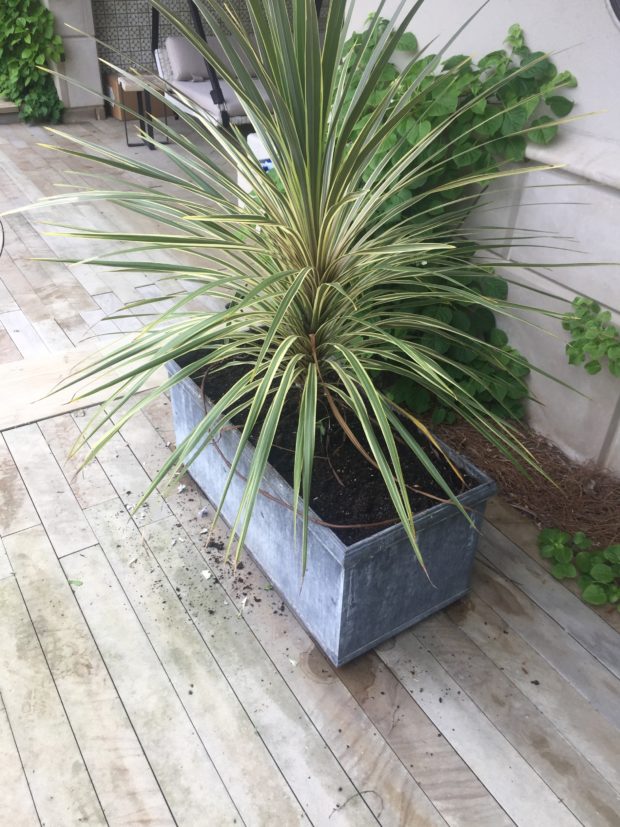 The cordyline pictured above is a fairly new variety with a beautiful variegation. I bought it as a 4″ pot. Not so impressive in that little pot. I recall it had five long leaves. No one shopping for plants at Detroit Garden Works that spring season spoke for it. At the end of the season, I could not bring myself to pitch it out. My grower overwinters plants from the shop and my good clients as a courtesy. I know the work of this is a lot of trouble for him, so I hope the materials he custom grows for us and the container plants we buy from him non stop in the spring season helps to balance out his willingness to hold over plants for us. Many of those plants are large old topiary plants belonging to clients – eugenias, boxwoods, jasmine, scented geranium standards, ferns and the like. Not a 4″ cordyline. But he was good natured about it. A number of little but beautiful cordylines spent the winter with him, in an unheated greenhouse that rarely dipped below 40 degrees. In the spring, I scooped up that spiky plant, and planted it in a container at home. How I loved the the olive green, cream and brown variegation. I wintered it over again, in a much more robust state, and planted it at home in a container for a second season. By this spring, that cordyline had a substantial presence. It was ready for a placement in a container garden of a client. An under planting of pansies was all it needed.
The cordyline pictured above is a fairly new variety with a beautiful variegation. I bought it as a 4″ pot. Not so impressive in that little pot. I recall it had five long leaves. No one shopping for plants at Detroit Garden Works that spring season spoke for it. At the end of the season, I could not bring myself to pitch it out. My grower overwinters plants from the shop and my good clients as a courtesy. I know the work of this is a lot of trouble for him, so I hope the materials he custom grows for us and the container plants we buy from him non stop in the spring season helps to balance out his willingness to hold over plants for us. Many of those plants are large old topiary plants belonging to clients – eugenias, boxwoods, jasmine, scented geranium standards, ferns and the like. Not a 4″ cordyline. But he was good natured about it. A number of little but beautiful cordylines spent the winter with him, in an unheated greenhouse that rarely dipped below 40 degrees. In the spring, I scooped up that spiky plant, and planted it in a container at home. How I loved the the olive green, cream and brown variegation. I wintered it over again, in a much more robust state, and planted it at home in a container for a second season. By this spring, that cordyline had a substantial presence. It was ready for a placement in a container garden of a client. An under planting of pansies was all it needed.
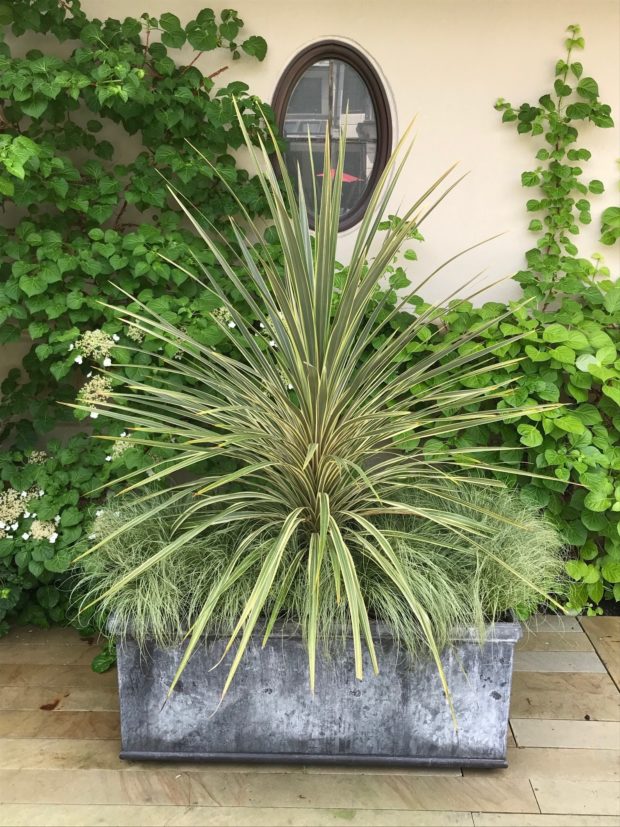 This summer planting of that mature specialty cordyline under planted with frosted curls grass delights me. A simple but visually strong planting, this. It looked terrific in the early spring, under planted with pansies. There was no need to dig it out of this box, and cast it aside. It will represent the summer in much the same beautiful way as it celebrated the spring. Surely this cordyline will sail through the fall. We are so fortunate that we have a grower who permits us to park plants with him in an unheated space over the winter. It is a rare grower who caters to an end user clientele who will winter over container plants. The cost of heating a glass house over the winter in our zone is prohibitive. It makes sense that most specialty tropical plants that are better than a year old are grown in parts of the US that do not experience temperatures below freezing. Many of the large tropical plants we see available are grown in Florida.
This summer planting of that mature specialty cordyline under planted with frosted curls grass delights me. A simple but visually strong planting, this. It looked terrific in the early spring, under planted with pansies. There was no need to dig it out of this box, and cast it aside. It will represent the summer in much the same beautiful way as it celebrated the spring. Surely this cordyline will sail through the fall. We are so fortunate that we have a grower who permits us to park plants with him in an unheated space over the winter. It is a rare grower who caters to an end user clientele who will winter over container plants. The cost of heating a glass house over the winter in our zone is prohibitive. It makes sense that most specialty tropical plants that are better than a year old are grown in parts of the US that do not experience temperatures below freezing. Many of the large tropical plants we see available are grown in Florida.
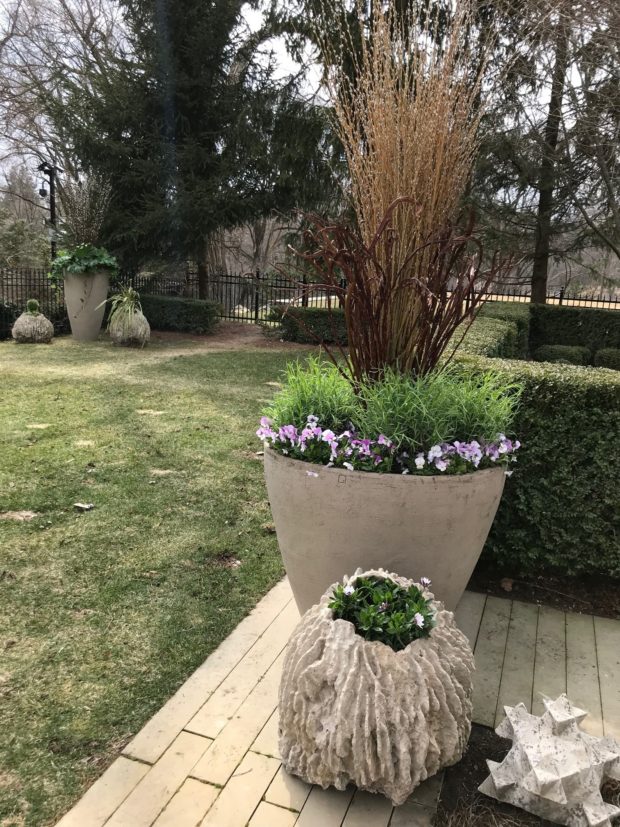 This spring planting here featured a centerpiece of fresh cut pussy willow and fan willow. In a circle all around that centerpiece, a number of gallon pots of lavender. The low stone planter was stuffed with white osteospermum. Rob buys in lots of large lavender plants early in the spring. They are remarkably cold tolerant, and their good size right from the start makes an impact in spring pots.
This spring planting here featured a centerpiece of fresh cut pussy willow and fan willow. In a circle all around that centerpiece, a number of gallon pots of lavender. The low stone planter was stuffed with white osteospermum. Rob buys in lots of large lavender plants early in the spring. They are remarkably cold tolerant, and their good size right from the start makes an impact in spring pots.
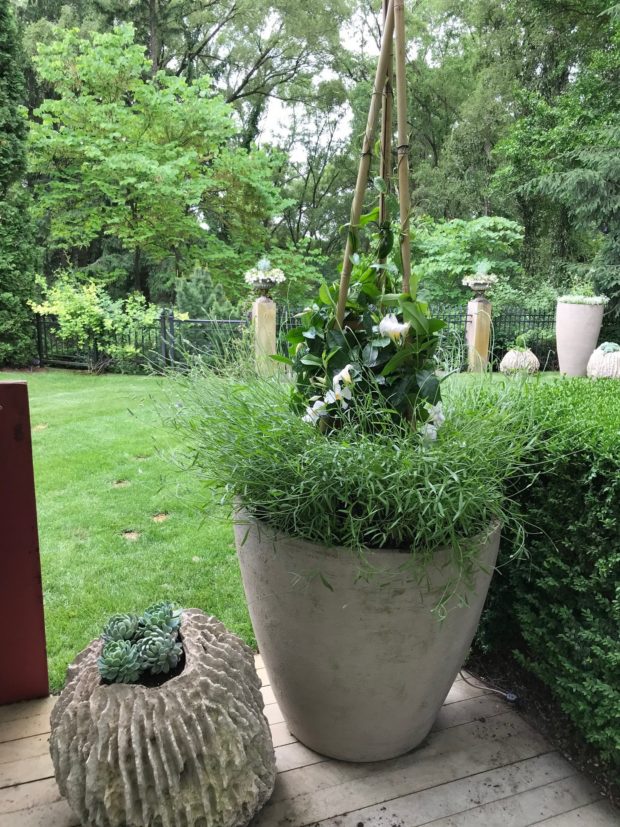 The lavender was just coming in to its own when it came time to plant for summer. The cut twig spring centerpiece was replaced with a white mandevillea. Summer for this container-done. Both mandevillea and lavender like conditions on the dry side, so the summer container design melds the old plants with the new. The osteospermum did get replaced with a quartet of blue foliaged escheverias, the color of which echoes the color of the lavender stems and foliage.
The lavender was just coming in to its own when it came time to plant for summer. The cut twig spring centerpiece was replaced with a white mandevillea. Summer for this container-done. Both mandevillea and lavender like conditions on the dry side, so the summer container design melds the old plants with the new. The osteospermum did get replaced with a quartet of blue foliaged escheverias, the color of which echoes the color of the lavender stems and foliage.
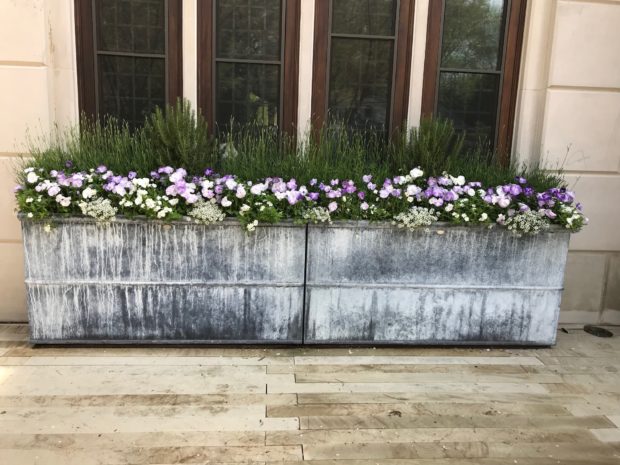 This pair of planter boxes repeated the same lavender, and a pair of rosemary standards in the back row. The front row is filled with classic early Michigan spring container plants – pansies, violas, sweet alyssum and annual white phlox intensia.
This pair of planter boxes repeated the same lavender, and a pair of rosemary standards in the back row. The front row is filled with classic early Michigan spring container plants – pansies, violas, sweet alyssum and annual white phlox intensia.
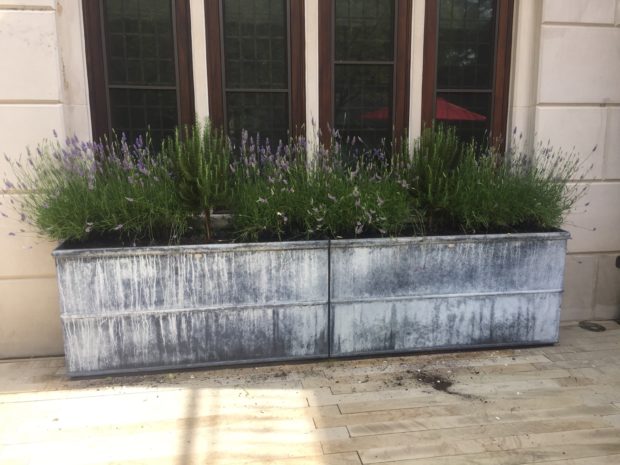 Once the spring plants were removed, it was obvious to see that the lavender and rosemary were thriving. The initial investment in those plants is offset by the fact that they will perform in these boxes another two seasons. Should you garden in a warm climate, carrying over plants from season to season or year to year is probably a given. But Michigan is noted for having four distinct seasons with widely varying conditions. These rosemarys would have to be wintered in a cool indoor space for the winter. The lavender is usually successful over the winter in the ground, provided they have perfect drainage.
Once the spring plants were removed, it was obvious to see that the lavender and rosemary were thriving. The initial investment in those plants is offset by the fact that they will perform in these boxes another two seasons. Should you garden in a warm climate, carrying over plants from season to season or year to year is probably a given. But Michigan is noted for having four distinct seasons with widely varying conditions. These rosemarys would have to be wintered in a cool indoor space for the winter. The lavender is usually successful over the winter in the ground, provided they have perfect drainage.
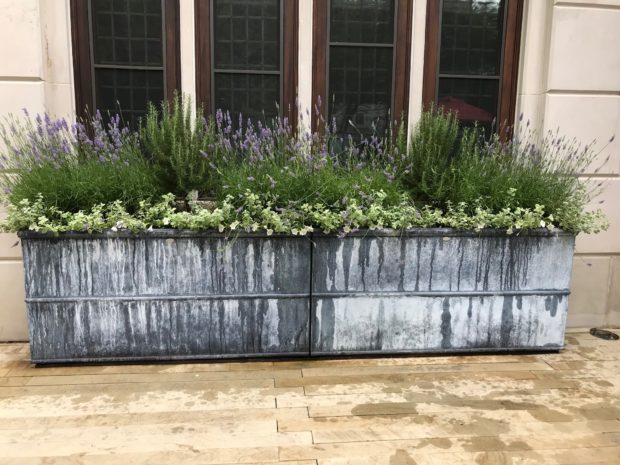 We planted the front row of these boxes with variegated licorice, and a second crop of 4″ petunias. The petunia plants are small, but they are rooted to the bottom of the pot. They are at a perfect stage to transplant. The top growth will come later.
We planted the front row of these boxes with variegated licorice, and a second crop of 4″ petunias. The petunia plants are small, but they are rooted to the bottom of the pot. They are at a perfect stage to transplant. The top growth will come later.
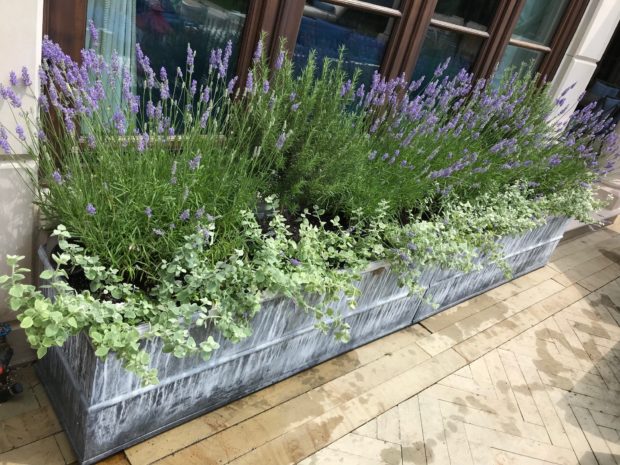 The petunias and licorice like the same conditions as the established rosemarys and lavender, so the watering will be a simple one size fits all.
The petunias and licorice like the same conditions as the established rosemarys and lavender, so the watering will be a simple one size fits all.
 Not every spring pot has plants that can be carried over. We do use preserved eucalyptus, fresh cut spring branches and in this case, metal picks that look like Queen Anne’s lace, in the interest of variety. Spring is the toughest season to plant in our zone. Not so many plants can tolerate the cold, and most of them that do are of small stature.
Not every spring pot has plants that can be carried over. We do use preserved eucalyptus, fresh cut spring branches and in this case, metal picks that look like Queen Anne’s lace, in the interest of variety. Spring is the toughest season to plant in our zone. Not so many plants can tolerate the cold, and most of them that do are of small stature.
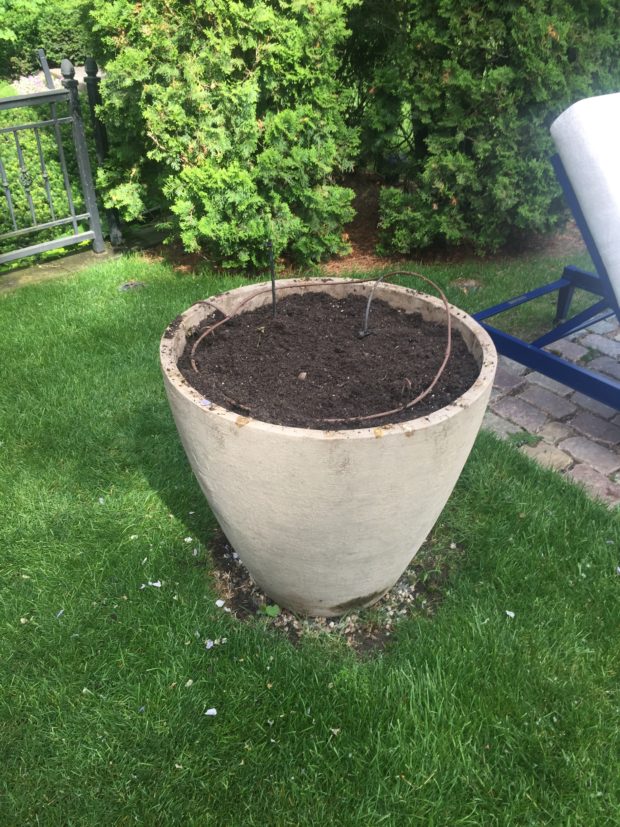 Once this pot was cleaned out, the top 10″ of soil is replaced with fresh soil. If there is a suspicion that the cypress bark mulch in the bottom half of the container has deteriorated and is no longer draining well, we empty the entire pot, and start fresh. For pots that are tall, or for plantings that require fast drainage, we may use large gravel rather than an organic material in the bottom. It is a good idea to use drainage material that can be carried over in giant pots that are difficult or time consuming to empty. Essential to maintaining the exit of water from the pot is a layer of landscape fabric between the soil and the drainage material. Soil that works its way down into the drainage layer will eventually interfere with the drainage.
Once this pot was cleaned out, the top 10″ of soil is replaced with fresh soil. If there is a suspicion that the cypress bark mulch in the bottom half of the container has deteriorated and is no longer draining well, we empty the entire pot, and start fresh. For pots that are tall, or for plantings that require fast drainage, we may use large gravel rather than an organic material in the bottom. It is a good idea to use drainage material that can be carried over in giant pots that are difficult or time consuming to empty. Essential to maintaining the exit of water from the pot is a layer of landscape fabric between the soil and the drainage material. Soil that works its way down into the drainage layer will eventually interfere with the drainage.
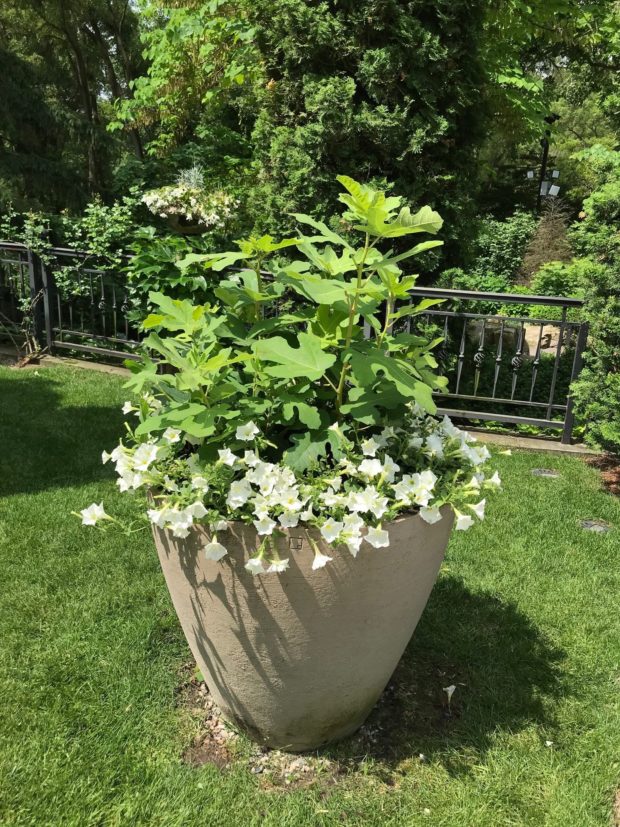 The figs and petunias will summer well in this pot. These are Chicago figs, meaning they are hardy as far north as Chicago. We will winter over good looking specimens at the end of the summer. If a client has a protected and well drained spot for them, they can spend the winter outdoors.
The figs and petunias will summer well in this pot. These are Chicago figs, meaning they are hardy as far north as Chicago. We will winter over good looking specimens at the end of the summer. If a client has a protected and well drained spot for them, they can spend the winter outdoors.
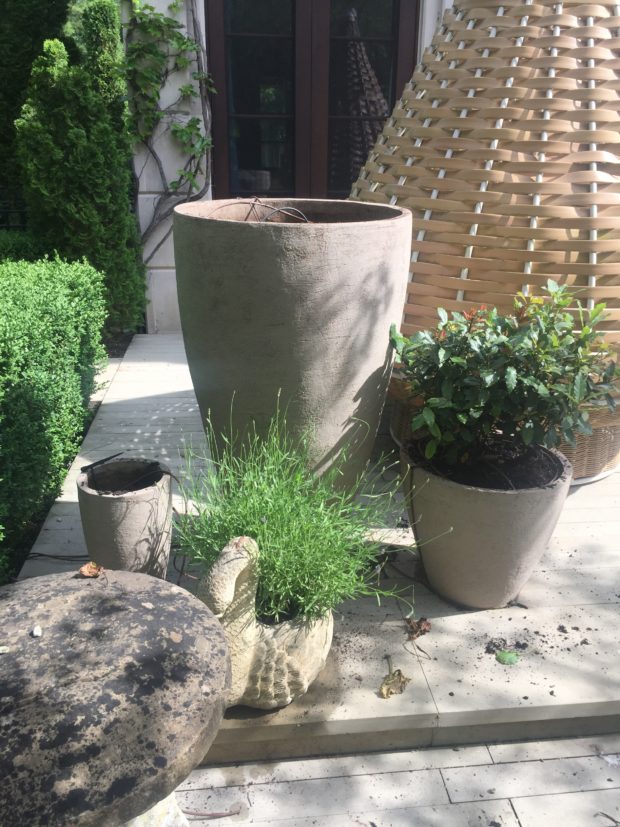 To follow are more pictures of the switch to summer.
To follow are more pictures of the switch to summer.
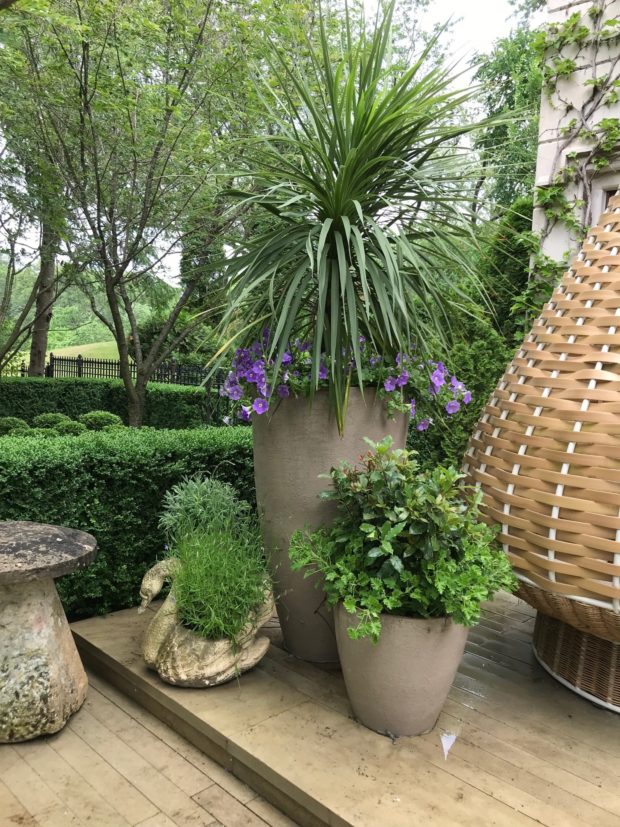 Yes, this spike has been wintered over several times. Having large material available for large pots means the resulting planting is proportional to the size of the pot. The bay plants in the foreground pot have a new collar of scented geraniums which will grow wide.
Yes, this spike has been wintered over several times. Having large material available for large pots means the resulting planting is proportional to the size of the pot. The bay plants in the foreground pot have a new collar of scented geraniums which will grow wide.
 spring container planted in mid April
spring container planted in mid April
 summer planting with a Persian lime and diamond frost euphorbia
summer planting with a Persian lime and diamond frost euphorbia
 The spring planting in this area features a Limelight hydrangea on standard under planted with lavender.
The spring planting in this area features a Limelight hydrangea on standard under planted with lavender.
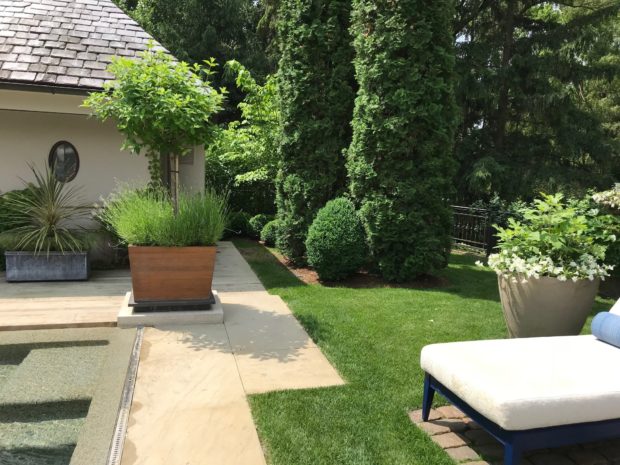 That pot will go on through the fall unchanged. Note that the hydrangea in this pot will get more water than the surrounding lavender. Selective watering in containers such as this one can make a huge difference in the outcome.
That pot will go on through the fall unchanged. Note that the hydrangea in this pot will get more water than the surrounding lavender. Selective watering in containers such as this one can make a huge difference in the outcome.
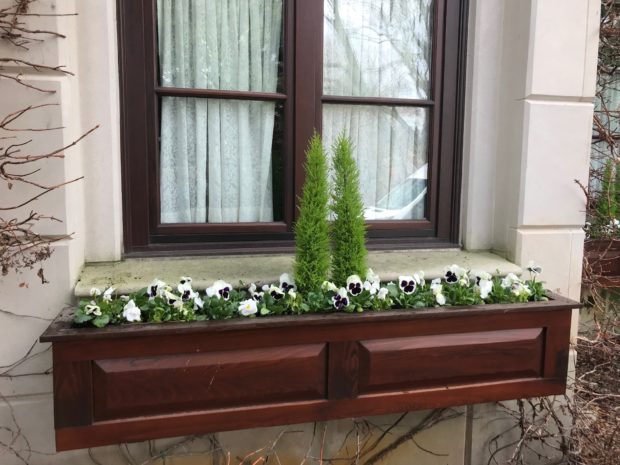 spring window box featuring lemon cypress
spring window box featuring lemon cypress
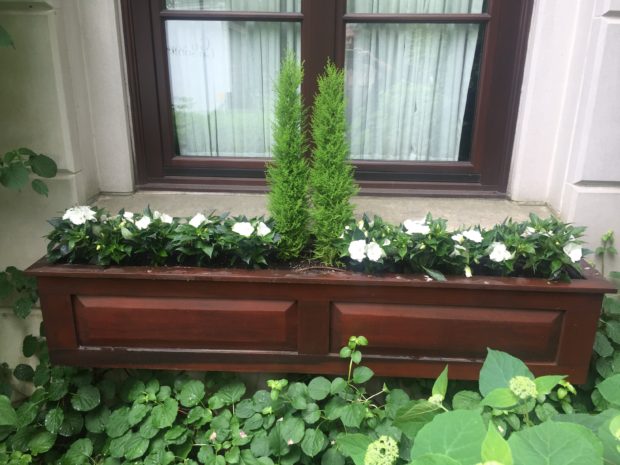 same box for summer. Eventually, the lemon cypress planted on either side of the bar in the box will grow together, and read as one.
same box for summer. Eventually, the lemon cypress planted on either side of the bar in the box will grow together, and read as one.
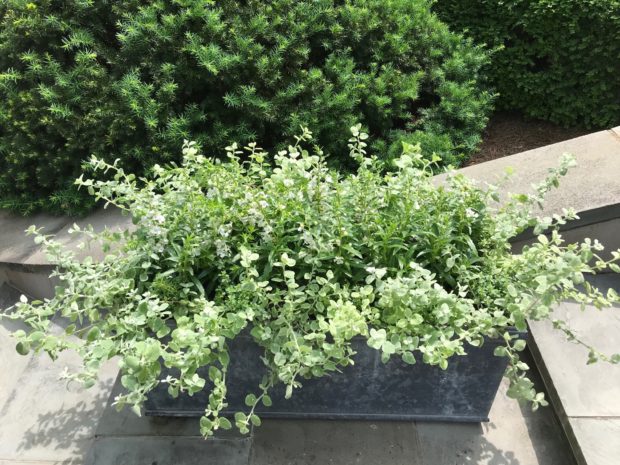 white angelonia and variegated licorice – ready for summer.
white angelonia and variegated licorice – ready for summer.
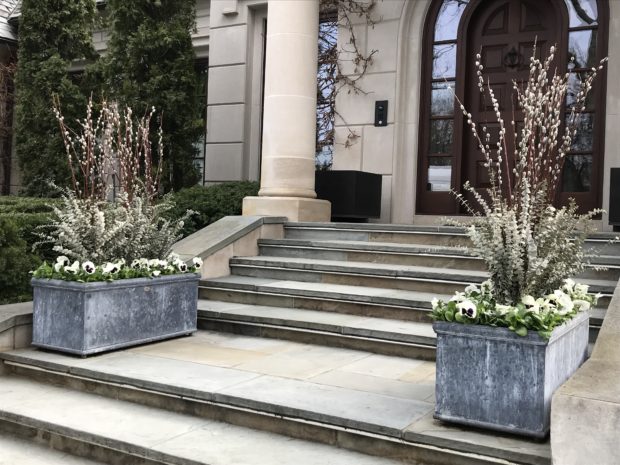
ve the way you have used pussy willows in your early spring container arrangements – especially the use of Salix udensis ‘Sekka’, a fabulous freaky fascinating fasciated form willow. The deep mahogany to burgundy stems are highly prized by florists for Ikebana floral arrangements and in winter containers outdoors.
Once again, you give wonderful information in your postings – “landscape fabric between the soil and the drainage material.” It is a fantastic tip that I will be sure to try when planting a large pot. Thank you!!!
Curious how you do “selective watering” in the pots with the lavender and hydrangea.
Dear Karen, it is possible to apply water slowly and directly to the hydrangea rootball. A garden laid out with drip irrigation will feature many water lines set fairly close together. Water that slowly leaks out of those lines soaks in right under – as in straight down under the line. The water does not move sideways unless the water is applied rapidly. Hope this explains it. The short version is that is is easy to water one plant, and avoid watering the other. best, Deborah
Always so fun to see your beautiful pots. Thanks for sharing Deborah. Happy Summer Solstice coming up this week.
Do you do any pruning of the lavenders when they are used in containers or do you let the spent blooms stems just add texture to the composition?
Dear Michaele, we cut back the dead flower heads, in hopes they will bloom again. They usually do. all the best, Deborah
What a lovely post. I do so much enjoy reading each one. Love your perspective and appreciate the education you give so freely. In the fourth photo you have the most intriguing pot….is that something available thru Detroit Garden Works???
I have two textile and clean 3/4″ gravel as drainage for years and recycle each year
Always wonderful Deborah and great tips! I LOVE your containers, sent a message on your sale but could not figure out where to go for price and buying. They are GORGEOUS
I believed you last year and cried when I read you were ending the garden cruises. I cried again last week when I read there was a garden cruise this sunday and I could not get there. I live in Marietta, GA and would need advance notice to work out all the logistics. So I did the next best thing, bought a $50 ticket which I will not use (in essence, made a donation). BUT, if you are doing it next year, PLEASE give your around the country groupies a couple of months advance warning, so we can make all the necessary plans to attend and check this off our bucket lists. Hope to see you this time next year!
Dear Denise, I am so sorry that you did not have more notice. I had to wait until the Erb Foundation made its decision to match dollars for the cruise, and they did not do that until April. Then it takes time to line up the gardens. But I can say there will be a cruise next year. For sure. And it will be the 3rd Sunday in July, as it has always been. I hope you will be able to come. And I will post plenty of pics of this years cruise. best regards, Deborah